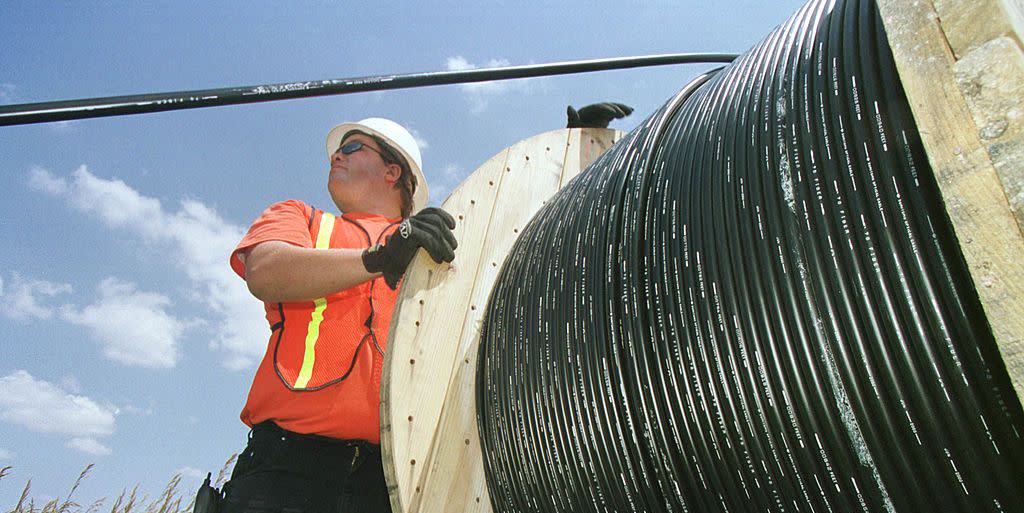How Scattering Light Could Power a Microchip Revolution

Brillouin scattering is seen as a natural hinderance in fiber optic cables.
New developments in artificial Brillouin scattering could revolutionize circuits.
By controlling how they operate, circuits could use sound waves to integrate optical information.
Fiber optics are the world's hidden backbone, spanning oceans and connecting continents. Giant companies like Microsoft and Facebook join forces to create these cables, like the Marea subsea cable, which connects from Virginia to Spain. These cables give off a type of feedback that many in the industry consider bothersome, but that a group of scientists believes could develop a new generation of integrated circuits, leading to a potential revolution in everything from 5G and broadband networks to defense systems.
Analysts estimate there are 378 submarine cables in service across the globe, consisting of 1.2 million kilometers (0.7 million miles). As information zips back and forth through these cables, light waves bounce around inside, hitting against polymer and silica fibers. The energy from these bounces create tiny vibrations known as phonons. These phonons create feedback in the form of tiny acoustic waves, which in turn interrupt the original light waves. This interruption is known as "Brillouin scattering."
Discovered in 1922, Brillouin scattering has been something of a headache for fiber optic cables because it can reduce signal power—but that could all change very soon.
"It's no exaggeration to say there is a research renaissance into this process under way," says Professor Ben Eggleton, Director of the University of Sydney Nano Institute and co-author of a review paper published today in Nature Photonics, in a press statement.
"The application of this interaction between light and sound on a chip offers the opportunity for a third-wave revolution in integrated circuits."
An international effort between Australian and American universities, "this paper outlines the rich physics that emerges from such a fundamental interaction as that between light and sound, which is found in all states of matter," says Professor Gaurav Bahl from the University of Illinois at Urbana-Champaign.
"Not only do we see immense technological applications, but also the wealth of pure scientific investigations that are made possible. Brillouin scattering of light helps us measure material properties, transform how light and sound move through materials, cool down small objects, measure space, time and inertia, and even transport optical information."
The progress started in the 1960s and 70s, when a process known as stimulated Brillouin scattering (SBS) was developed. An SBS is essentially a feedback loop of phonons (sound) and photons (light). During this process, sound waves and light waves are coupled, even though light waves are much faster.
"The big advance here is in the simultaneous control of light and sound waves on really small scales," says Professor Christopher Poulton at the University of Technology Sydney, a co-author.
"This type of control is incredibly difficult, not least because the two types of waves have extremely different speeds. The enormous advances in fabrication and theory outlined in this paper demonstrate that this problem can be solved, and that powerful interactions between light and sound such as Brillouin scattering can now be harnessed on a single chip. This opens the door to a whole host of applications that connect optics and electronics."
The payoff, Eggleton says, will come in the form SWAP: size, weight and power. That comes from a greater ability to manipulate an SBS.
"Managing information on a microchip can take up a lot of power and produce a lot of heat," Professor Eggleton says.
"As our reliance on optical data has increased, the process of interaction of light with microelectronics systems has become problematic. The SBS process offers us a completely new way to integrate optical information into a chip environment using sound waves as a buffer to slow down the data without the heat that electronic systems produce.
"Further, integrated circuits using SBS offer the opportunity to replace components in flight and navigation systems that can be 100- or a 1000-times heavier. That will not be a trivial achievement."
There's still a lot of work to be done. First and foremost, the team needs to build an architecture that integrates microwave and radio frequency processors with optical-acoustic interactions. Then, there's the issue of eliminating any unwanted light scattering. Some of the team suggests building the SBS chips in near absolute-zero temperatures, which would be tremendous energy expenditure in itself. There's also the issue of the tubes themselves, which would need to be built out of materials flexible enough to contain SBS interactions.
But the team is optimistic about the chance for future breakthroughs. "This new paradigm in signal processing using light waves and sound waves opens new opportunities for fundamental research and technological advances," Eggleton says.
Source: University of Sydney
You Might Also Like

